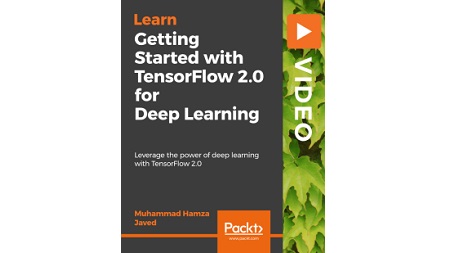
English | MP4 | AVC 1920×1080 | AAC 48KHz 2ch | 1h 54m | 1.35 GB
Learn to develop deep learning models and kickstart your career in deep learning with TensorFlow 2.0
Deep learning is a trending technology if you want to break into cutting-edge AI and solve real-world, data-driven problems. Google’s TensorFlow is a popular library for implementing deep learning algorithms because of its rapid developments and commercial deployments.
This course provides you with the core of deep learning using TensorFlow 2.0. You’ll learn to train your deep learning networks from scratch, pre-process and split your datasets, train deep learning models for real-world applications, and validate the accuracy of your models.
By the end of the course, you’ll have a profound knowledge of how you can leverage TensorFlow 2.0 to build real-world applications without much effort.
Learn
- Develop real-world deep learning applications
- Classify IMDb Movie Reviews using Binary Classification Model
- Build a model to classify news with multi-label
- Train your deep learning model to predict house prices
- Understand the whole package: prepare a dataset, build the deep learning model, and validate results
- Understand the working of Recurrent Neural Networks and LSTM with hands-on examples
- Implement autoencoders and denoise autoencoders in a project to regenerate images
Table of Contents
Deep Learning Basics
1 The Course Overview
2 Introducing Deep Learning and Setting Up the Environment
3 Introducing the Universal Workflow of Deep Learning
4 Mathematics Refresher
5 Training, Validation, and Test Sets
6 Data Preprocessing and Feature Engineering for Deep Learning Models
7 Demonstrating Overfitting and Underfitting of Data
TensorFlow 2.0 for Deep Learning
8 TensorFlow 2.0 Benefits and New Features
9 Neural Network in TensorFlow 2.0
10 Getting and Preprocessing MNIST Dataset
11 Building Neural Network for Classifying CIFAR10 Dataset in Jupyter Notebook
12 TensorBoard and Callbacks
Working with CNNs for Computer Vision and Deep Learning
13 Introduction to Convolutional Neural Networks
14 Loading the Dataset, and Making Train and Test Sets
15 Dataset Preprocessing
16 Building CNN Model from Scratch with on Home Objects Dataset
17 Data Augmentation to Overcome Overfitting and Generate Similar Images
Working with LSTM for Text Data and Deep Learning
18 Introducing LSTM and Recurrent Neural Networks
19 Downloading and Working Textual Data – N-Grams and Bag-Of-Words
20 Using GloVe Word Embeddings
21 Building LSTM Model for Text Data and Getting the Results
Working with RNNs for Time Series Sequences and Deep Learning
22 Introducing Recurrent Neural Networks
23 Getting and Preprocessing the Temperature Data
24 Building RNN Model for Temperature Forecasting
Autoencoders AE and Denoising AE
25 What Are Autoencoders Why Are They Used
26 Creating Simple Autoencoders from Scratch with Fashion-MNIST Dataset
27 Going in Depth with Deep Autoencoders
28 Reconstruct Images with Denoising Autoencoders
Deep Learning Mini-Projects
29 TensorFlow 2.0 High Level API and Keras-API
30 Getting and Preprocessing IMDB Dataset for Binary Classification
31 Dataset Preparation, Building, and Validating Results on IMDB Dataset
32 Getting and Preprocessing Reuters Dataset for Multi-Label Classification
33 Dataset Preparation, Building, and Validating Results on Reuters Dataset
34 Getting and Preprocessing Dataset for Regression Analysis
35 Dataset Preparation on Boston Housing Price Dataset
Resolve the captcha to access the links!